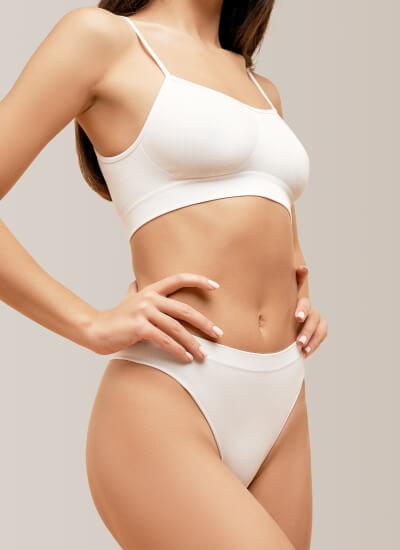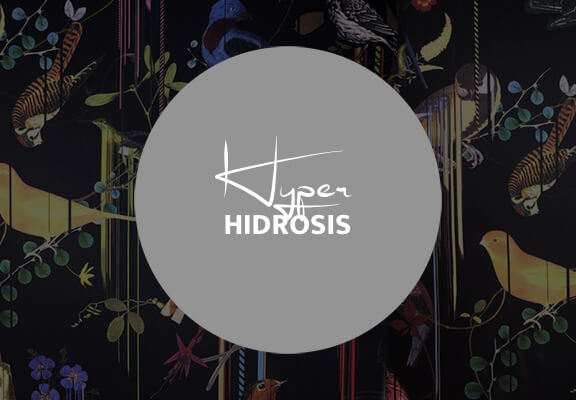Hyperhidrosis
Facts on hyperhidrosis

| Treatment methods: | Botox or suction curettage |
| Treatment duration: | 30 min to 1,5 hours |
| Anaesthesia: | Local anaesthetica |
| Post-treatment: | Gentle compression |
| Presentable: | 1–2 days for suction curettage; immediately after Botox |
| Costs: | From 300 € |
Perspiration is an entirely natural process which the body uses to cool itself in high temperatures. How soon and how much we sweat differs from one person to the next. However, some people suffer from abnormally increased sweating. Hyperhidrosis is a condition in which a person’s hands, feet or armpits produce more sweat than usual without any apparent cause.
Heavy sweating is doubly troubling for those who suffer from it. On the one hand, the problem can’t be controlled or remedied by conventional means; on the other hand, in social environments excessive sweating is often perceived as a sign of poor hygiene, which sets in motion a vicious cycle of its own. Many of those who suffer from hyperhidrosis bear a heavy burden and limit their social life as a result.
Two methods in particular have proven to be effective treatments for hyperhidrosis: Botox treatments and surgery to remove the sweat glands. While Botox injections need to be repeated at regular intervals, removing the sweat glands allows us to achieve long-lasting results. We would be happy to discuss the advantages and disadvantages of each treatment with you in our practice.
Frequently asked questions on Hyperhidrosis
Hyperhidrosis is a medical term which denotes abnormally increased sweat production. The condition can affect the entire body or be localised to specific regions – the most common being the hands, feet and armpits. A differentiation is made between primary and secondary hyperhidrosis. Primary hyperhidrosis is usually limited to certain areas of the body. To this day, researchers have been unable to clearly establish its causes.
Secondary hyperhidrosis denotes generally increased sweat production levels which can be caused by a variety of factors. These causes include hormone imbalances, infections, high blood pressure and neurological conditions. Diabetes can also trigger hyperhidrosis, as can ingestion of certain medications.
Various procedures have been developed to treat hyperhidrosis, including both surgical and minimally invasive methods. If excessive sweat production can be ascribed to an underlying condition, it’s first and foremost this condition that should be treated.
At Central Aesthetics, we offer our patients two proven methods to combat hyperhidrosis: Botox injections and surgical removal of the sweat glands. In the Botox method, we inject the botulinum toxin under the skin at various locations. By doing so, we block the chemical messenger responsible for triggering sweat production, dramatically reducing the amount of sweat produced. To achieve lasting results, the Botox treatment needs to be repeated at regular intervals.
Surgery to remove sweat glands is a potential solution for patients who have been unable to achieve their desired results through minimally invasive treatments. In this method, the armpits’ sweat glands are either vacuumed out using special cannulas or removed through abrasion. While surgical gland removal is comparatively complex, it does achieve long-lasting results.
Before the treatment, your therapist will hold a one-to-one consultation with you to discuss the prospects and risks. They’ll then work with you to select the appropriate form of therapy for you and establish a treatment plan. In addition, they’ll give you precise information on how to prepare for therapy. For example, before an operation to remove sweat glands, you’ll need to stop taking certain medication that could impair blood coagulation. The Botox treatment doesn’t usually require any specific preparation.
After a hyperhidrosis treatment with Botox, you’ll be able to get back to your work and social commitments straight away. However, you should avoid visiting the sauna, sunbathing and exercising for a few days. Surgical sweat gland removal, on the other hand, requires a few days’ convalescence. After the procedure, patients have to wear a special compressive vest.
Hyperhidrosis treatment varies for each individual patient depending on the method selected. We usually perform the Botox treatment as an outpatient procedure. To begin with, the relevant areas are disinfected and numbed with a mild anaesthetic if required. The therapist then injects the heavily diluted botulinum toxin under the skin using a fine needle. The entire treatment only takes around 30–60 minutes, and you can leave the practice again immediately afterwards.
The surgical procedure to remove sweat glands takes around 1–2 hours; we usually perform it as an outpatient procedure under local anaesthetic. After the anaesthetic has been administered, the surgeon makes a series of small incisions in the armpit. They then use a special cannula to suck out the sweat glands in a similar manner to liposuction. After this suction, the wounds are sutured and an adhesive or compressive bandage applied. The patient is usually able to leave the practice again the same day.
Hyperhidrosis treatment using Botox does not require any downtime on the part of the patient. However, you should allow several days to recover from a procedure to surgically remove sweat glands. Generally speaking, our patients are able to fulfil their usual social commitments after 2–3 days.
The Botox treatment is a low-risk procedure in which complications are extremely rare. At most, patients might notice some slight redness or swelling for a short period after the procedure, though such symptoms usually subside completely within a few days.
Surgical removal of sweat glands involves general operative risks present in all surgical procedures. Potential complications include infections, wound healing disorders and secondary haemorrhages. When carried out by a specialist, damage to the surrounding tissue is extremely rare. As the wounds heal, prominent scars usually develop at first before receding and fading away over the course of time.
Surgery to remove sweat glands generally allows us to achieve long-lasting results. In very rare cases, parts of the removed sweat glands can grow back, which could make a follow-up treatment necessary.
The effects of Botox injections will start to fade after 4–7 months. To achieve lasting results, the Botox treatment should be repeated at regular intervals.
We’ll be able to provide you with precise details of the costs of treatment in your individual case in a non-binding consultation appointment.
Address
Central Aesthetics by Dr. Deb
Mainzer Landstraße 65
60329 Frankfurt am Main
Opening hours
| Monday | 8:30am - 6:00pm |
| Tuesday | 8:30am - 6:00pm |
| Wednesday | 8:30am - 6:00pm |
| Thursday | 8:30am - 6:00pm |
| Friday | 8:30am - 6:00pm |
and by appointment




